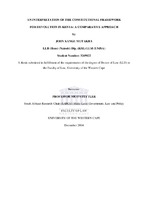| dc.description.abstract | Kenya adopted a new Constitution in 2010, with devolution of political power, responsibilities and resources to newly created counties as its centrepiece and most transformative aspect. Devolution was intended to address the many governance, economic and development problems of the country, which arose from the long history of a highly centralised, undemocratic and inequitable system. The main problem, however, is how to give effect to the stated intent of the Kenyan people and make devolution as envisaged, a reality. This is compounded by the fact that devolution’s constitutional design has its provisions spread across and permeating the entire Constitution. Thus, the main aim of this thesis was to give a coherent and purposeful interpretation of the constitutional provisions on devolution in order to realise the objectives and intent of the Kenyan people. This study has advanced the argument that the central nature of devolution and its intended objectives can be realised through a purposive interpretation. This entails the practical realisation and application of the constitutional provisions by identifying the objects and purposes of devolution and giving effect to them. Such interpretation draws on textual, structural, contextual and historical elements. The Constitution is interpreted as a whole, taking into account both intra-textual and extra-textual context, including the social, economic, political and cultural context of the country in its historical and contemporary dimensions. Comparative law, especially the South African jurisprudence and scholarly commentaries, provided instructive lessons, given the significant textual similarities between the Kenyan and South African constitutional provisions on devolution. A coherent and purposive interpretation has demonstrated that devolution was adopted to promote and advance democracy and accountability; development and service delivery; equity and inclusiveness; and limitation of centralised power. This is reflected in the values, objects and principles of devolution, which are not only aids for the interpretation of other provisions of the Constitution but also themselves operative provisions demarcating the limits of powers of the two levels of government. The interpretation demonstrates that the Constitution creates two distinct governments that must conduct their intergovernmental relations in a cooperative manner. The county governments are relatively autonomous; are represented in selected decision-making at the national level, through the Senate; and have both exclusive and concurrent powers. Although they have limited revenue-raising powers comprising property rates and entertainment taxes, they are entitled to a share of the revenue raised nationally as equitable shares and conditional or unconditional additional grants. The national government, however, has some limited and circumscribed supervision powers. These conclusions have been arrived at by interpreting the devolution- and county-empowering provisions liberally, broadly and generously in favour of the counties and devolution, and the national government intervention and devolution limiting provisions narrowly and strictly against the national government. In this process, the South African case law has been very useful in giving content to the purposive interpretation. | en_US |

